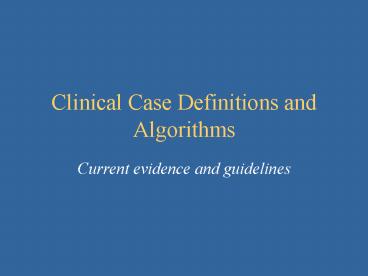Clinical Case Definitions and Algorithms PowerPoint PPT Presentation
1 / 20
Title: Clinical Case Definitions and Algorithms
1
Clinical Case Definitions and Algorithms
- Current evidence and guidelines
2
Major pathogens in children aged gt 60 days
- Meningitis
- Strep. Pneumoniae
- H. influenzae type B
- N. meningitidis
- Salmonella sp.
- Cryptococcus
- Viruses
- Pneumonia
- Viruses (RSV)
- Strep. Pneumoniae
- H. influenzae type B
- Salmonella sp.
- Mycoplasma
- PTB
- Staph. Aureus
- Chlamydia
- PCP
3
How can we be sure what the cause is?
- Meningitis
- Identify the organism in the CSF after lumbar
puncture. - Identify the organism in blood culture in a child
with a high CSF white cell count.
- Pneumonia
- Identify the organism from blood culture.
- Identify organism from culture of pleural fluid
or pus. - Rarely research settings - lung puncture
4
How often do we find out? Meningitis (1)
Organism identified in CSF
5
How often do we find out? Meningitis (2)
Correctly processed specimen
Time to the laboratory
Organism identified in CSF
6
How often do we find out? Meningitis (3)
Specimen correctly collected
Before antibiotics, prevent trauma, documentation
Correctly processed specimen
Time to the laboratory
Organism identified in CSF
7
How often do we find out? Meningitis (4)
Patients correctly assessed clinically, procedure
explained to parent
Patients correctly identified for investigation
Specimen correctly collected
Before antibiotics, prevent trauma, documentation
Correctly processed specimen
Time to the laboratory
Organism identified in CSF
Lack of resources
8
How often do we find out? Meningitis (5)
- In a survey last year in 14 hospitals in Kenya of
46 children with fever and a stiff neck or fever
and fits and irritability or agitation NO child
had an LP. - In Kilifi to detect 75 of all cases of
meningitis LPs would need to be done on 655
children a year, 1 in 9 of these will have
meningitis - 1 in 7 admissions need an LP!
9
How often do we find out? Pneumonia
Patients correctly assessed clinically, procedure
explained to parent
Patients correctly identified for investigation
Specimen correctly collected
Before antibiotics, documentation
Correctly processed specimen
Cold Time
Organism identified in Blood
Lack of resources
10
How often do we find out? Pneumonia (2)
- In Kilifi
- 100 cases very severe pneumonia a year, with 1
in 9 having a positive blood culture - 500 cases of severe pneumonia a year with 1 in
18 having a positive blood culture. - In South America (no malaria / no HIV)
- 1 in 10 cases severe pneumonia have a positive
blood culture
11
Effective surveillance
- You have to do a lot of investigations to pick up
only a small number of firmly identified causes. - You cannot test everyone.
- What is of benefit to the patient what would be
good medical practice?
12
Meningitis best clinical practice WHO 2000
- Consider the diagnosis if there is
- History of
- Vomiting
- Inability to drink breast feed
- Convulsions
- Irritability
- On examination
- Stiff neck
- Repeated convulsions
- A petechial rash or purpura
- Lethargy
- Irritability
- Bulging fontanelle
Management of the child with severe infection
malnutrition, IMCI referral care manual.
13
Meningitis best clinical practice WHO 2000
- Use of these IMCI type signs in an area like
Kilifi (malaria endemic) would mean that 40 of
admissions would be eligible for a lumbar
puncture (almost 2,000 a year)! - Can we narrow things down a bit to a must do a
lumbar puncture group?
14
Meningitis Indications for Lumbar puncture
(minimal) good practice guidelines
15
(No Transcript)
16
Pneumonia best clinical practice WHO 2000
- Consider the diagnosis if there is cough and / or
difficulty breathing and - Severe Pneumonia (currently recommended for IP
treatment with penicillin) - Lower chest wall indrawing
- Nasal flaring or grunting
- Very severe pneumonia (currently recommended for
IP treatment with chloramphenicol or gentamicin
and penicillin) - Central cyanosis
- Inability to breast feed or drink
- Signs of lobar pneumonia or effusion.
Management of the child with severe infection
malnutrition, IMCI referral care manual.
17
Pneumonia Indications for Blood culture
(minimal) good practice guidelines
18
(No Transcript)
19
Surveillance Information available from good
clinical practice
Patients correctly assessed clinically,
investigated appropriately and procedure
explained to parent
Specimen correctly collected to get the best
information to benefit the patient
Specimen correctly processed to get the best
information to benefit the patient
Organism identified, information available to
clinician and public health community (organism
type, not personal data)
20
Workshop on clinical definitions
- Minimal level of good clinical practice is this
acceptable? (Identifying cases) - Basic requirements for good sample collection.
- Basic requirements for good sample handling by
clinical staff - Basic requirements for clinical use of
information. - Measurement of how well things are going.

